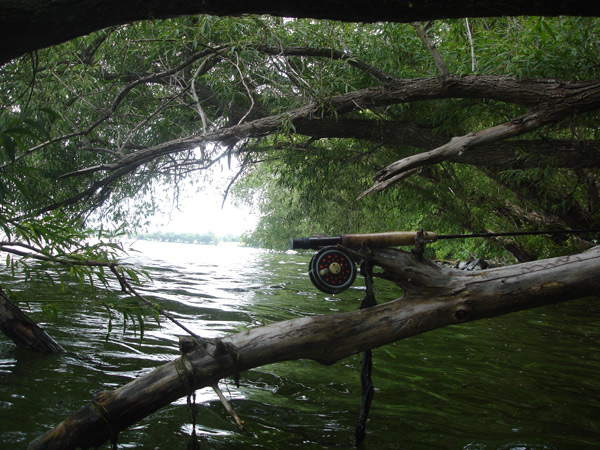Big Magic
By John Luthens

I can tell by the sun shadows through the trees that its time. On the far northeastern shore of Lake Winnebago, from the Indian Mound Trail in High Cliff State Park, the sun holds long in the sky before dropping into the far shores. The hardwood oaks and maples, hiding the Native American effigy mounds, hold the shadows long into the evening hours around the summer solstice-the longest day of the year. It’s a time of big magic.
The effigy mounds are ancient shapes, rising from the trees high above the greatest of inland lakes, and created some 1500 years ago by Siouan American Indians to honor their dead.
As reminders of days gone by, they are by no means huge, not like the pyramids or Stonehenge. If they weren’t part of the park system, and marked with signs to denote their distinct shapes, you might well walk right over their tops, mistaking them for simple rises and falls of the forest floor. Regardless of their physical stature, they are awe inspiring nonetheless.
They are awe inspiring in the way a solemn church cathedral is, when your footsteps echo loud to your own ears, but are then quickly swallowed by the vaulted ceilings. The high, dark shadows created by the forest surrounding the mounds can do that. And like a cathedral, where the stained glass windows reflect the light in cutting angles, the oaks and maples set above the mounds hold the light of the setting lake sun, throwing it back into the shadows.
At summer solstice-the cathedral show goes on the longest.
The effigy builders were nomadic, wandering the Midwest and following the growing season, stopping to camp where fish and game were plentiful. And where they stopped, in the never ending seasonal cycle, in places like High Cliff, they built the mounds as a testament of their passing.
High above the shores of Lake Winnebago, walking the Indian Mound Trail, I often wonder what they saw, and what they knew of the lake. I try to remember what I’ve seen and learned.
The warm weather was early this spring, and the shoreline fish were early with it. But I like to think I’ve learned that the walleyes come back to the lake from their spring spawning run when the apple trees start to blossom.
I found that the crappies were in close when two otters swam out of a certain channel to fish before dark.
By the time the mallard ducklings were swimming on their own, without hovering too close to mom, the bluegills were on their beds.
There are signs for bass too, like how bright the flowering weeds glow in the roadside ditches, or how the lilacs smell- either one, depending on if we’re talking largemouth or smallmouth.
I suppose I might tell all of that with a thermometer-to gauge the water temperature changes and nail down the yearly routines of the Winnebago fish a little more firmly-but it’s too scientific, not to mention too obvious for the spirits of High Cliff. It’s not enough big magic.
I made the pilgrimage again to High Cliff last week, in time to see the mounds in the last of the setting sun. Setting up my tent beneath the shadowed trees, I fell asleep late, and was up early. Those are the rights of passage to observe in this place when the summer solstice nears.
I crawled out of my tent in predawn darkness, and found the trail that drops down through the limestone crags, winding through rock and rubble to the lake shore. I crawled down the trail in waders with my fly rod in tow.
The Native Indians of this place must have known when the fish were gone from the shore and into the cooler and deeper reaches of the lake. Maybe they built the mounds in the hardwood forest above as a sun dial of sorts, so they didn’t have to trudge down the cliff each morning to see if the fish had moved out. Because when they were gone, it was time to either move the camp to a new area or start building canoes to go after the fish.
Me, I just stumble down the cliff in waders, around about summer solstice, to where the heavy green of the shoreline vegetation has pushed its way down off the cliffs and over the lake itself.
There are willows banked out over the rocky shores, creating tangled tunnels along the shore. I have a hunch that it’s a place to soak a leech at night under a lighted bobber, but I’ve never followed up on it.
It was warm wading in the water, and I could have just as easily left the bulky waders at home and opted for an old pair of tennis shoes. There were bumps on the end of my line, which might have been strikes, or might have been the rocks bumping my fly. It’s easier to think of them as strikes. It’s the kind of big magic that keeps me moving from one willow tangle to the next.
One smallmouth came to the brink of my net, it was only about twelve inches, and it fell off before I netted it. Besides that, all I got was some much needed practice casting under the overhanging trees. It’s the kind of casting that I’ll need for the full-summer growth of trout streams ahead.
When I hooked my fly in the branches, I just waded over and pulled it out. It was a lakeshore practice course. On a trout stream, when it’s for real, hooking a fly in the branches will mean one of two things: a lost fly or a harrowing wade across the stream, most likely resulting in cold water pouring over my wader tops. No fish either way in a deal like that.
After packing up camp, I drove for home, stopping off for a visit at the in-laws in New Holstein on the way. It was lunchtime, so the timing just seemed right. The truck was gone from the driveway, and the boat was gone with it. My mother-in-law was there, so at least I didn’t go away hungry.
She said my father-in-law was out fishing the mud flats in the middle of Winnebago. He’d been out every day all week, the walleyes were on fire. “If you’d have called, he would have taken you with him,” She told me as I munched a sandwich, nodding my head and trying not to spit out crumbs on her polished dining room table.
The fish have moved to deeper water. It was exactly what I’d deduced from my trip to High Cliff. My father-in-law doesn’t believe in big magic. He’s just smarter than me.









